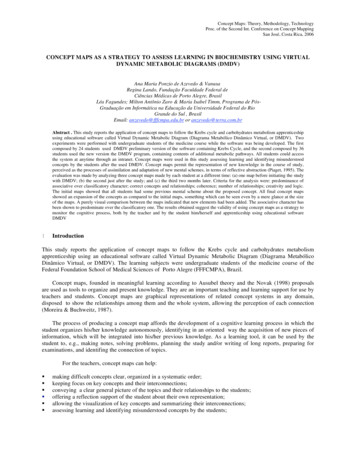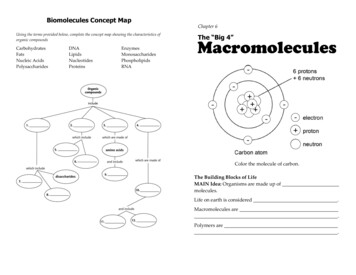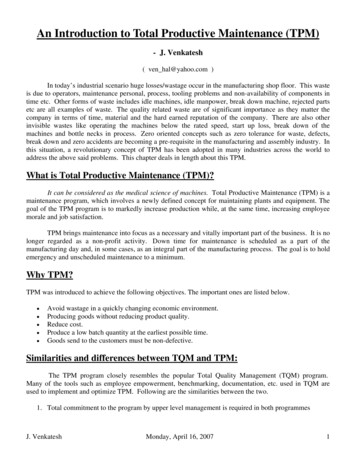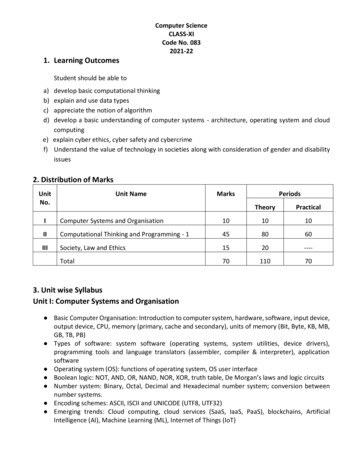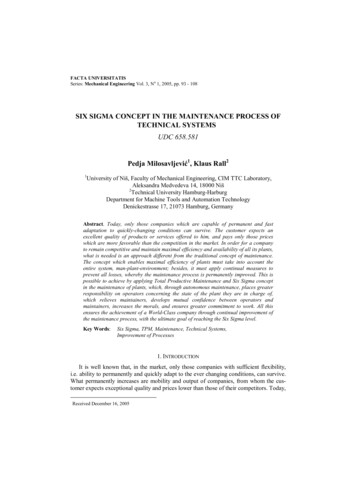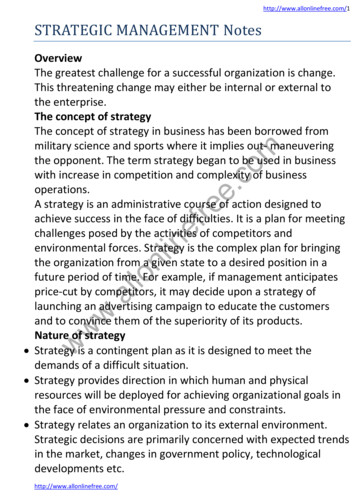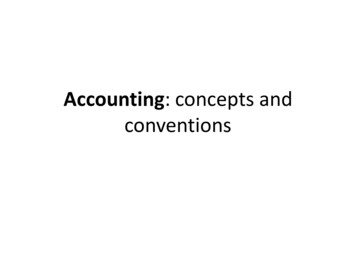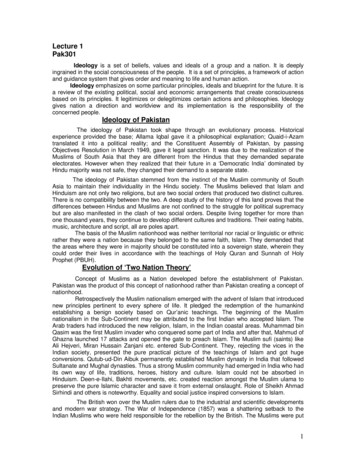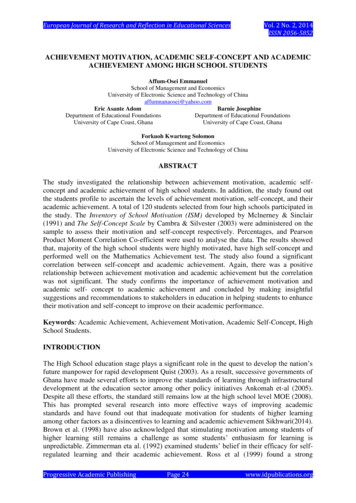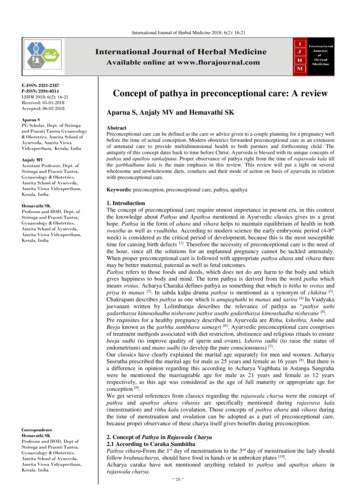
Transcription
International Journal of Herbal Medicine 2018; 6(2): 16-21E-ISSN: 2321-2187P-ISSN: 2394-0514IJHM 2018; 6(2): 16-21Received: 05-01-2018Accepted: 06-02-2018Aparna SPG Scholar, Dept. of Strirogaand Prasuti Tantra Gynaecology& Obstetrics, Amrita School ofAyurveda, Amrita ViswaVidyapeetham, Kerala, IndiaAnjaly MVAssistant Professor, Dept. ofStriroga and Prasuti Tantra,Gynaecology & Obstetrics,Amrita School of Ayurveda,Amrita Viswa Vidyapeetham,Kerala, IndiaHemavathi SKProfessor and HOD, Dept. ofStriroga and Prasuti Tantra,Gynaecology & Obstetrics,Amrita School of Ayurveda,Amrita Viswa Vidyapeetham,Kerala, IndiaCorrespondenceHemavathi SKProfessor and HOD, Dept ofStriroga and Prasuti Tantra,Gynaecology & Obstetrics,Amrita School of Ayurveda,Amrita Viswa Vidyapeetham,Kerala, IndiaConcept of pathya in preconceptional care: A reviewAparna S, Anjaly MV and Hemavathi SKAbstractPreconceptional care can be defined as the care or advice given to a couple planning for a pregnancy wellbefore the time of actual conception. Modern obstetrics forwarded preconceptional care as an extensionof antenatal care to provide multidimensional health to both partners and forthcoming child. Theantiquity of this concept dates back to time before Christ. Ayurveda is blessed with its unique concepts ofpathya and apathya sankalpana. Proper observance of pathya right from the time of rajaswala kala tillthe garbhadhana kala is the main emphasis in this review. This review will put a light on severalwholesome and unwholesome diets, conducts and their mode of action on basis of ayurveda in relationwith preconceptional care.Keywords: preconception, preconceptional care, pathya, apathya1. IntroductionThe concept of preconceptional care require utmost importance in present era, in this contextthe knowledge about Pathya and Apathya mentioned in Ayurvedic classics gives us a greathope. Pathya in the form of ahara and vihara helps to maintain equilibrium of health in bothswastha as well as vyadhitha. According to modern science the early embryonic period (4-8thweek) is considered as the critical period of development, because this is the most susceptibletime for causing birth defects [1]. Therefore the necessity of preconceptional care is the need ofthe hour, since all the solutions for an unplanned pregnancy cannot be tackled antenataly.When proper preconceptional care is followed with appropriate pathya ahara and vihara theremay be better maternal, paternal as well as fetal outcomes.Pathya refers to those foods and deeds, which does not do any harm to the body and whichgives happiness to body and mind. The term pathya is derived from the word patha whichmeans srotas. Acharya Charaka defines pathya as something that which is hitha to srotas andpriya to manas [2]. In sabda kalpa druma pathya is mentioned as a synonym of chikitsa [3].Chakrapani describes pathya as one which is anupaghathi to manas and sarira [4] In Vaidyakajeevanam written by Lolimbaraja describes the relevance of pathya as “pathye sathigadarthasya kimoushadha nishevane pathye asathi gadarthasya kimoushadha nishevane [5].Pre requisites for a healthy pregnancy described in Ayurveda are Rithu, kshethra, Ambu andBeeja known as the garbha sambhava samagri [6]. Ayurvedic preconceptional care comprisesof treatment methjods associated with diet restriction, abstinence and religious rituals to ensurebeeja sudhi (to improve quality of sperm and ovum), kshetra sudhi (to raise the status ofendometrium) and mano sudhi (to develop the pure consciousness) [7].Our classics have clearly explained the marital age separately for men and women. AcharyaSusrutha prescribed the marital age for male as 25 years and female as 16 years [8]. But there isa difference in opinion regarding this according to Acharya Vagbhata in Astanga Sangrahawere he mentioned the marriageable age for male as 21 years and female as 12 yearsrespectively, as this age was considered as the age of full maturity or appropriate age forconception [9].We get several references from classics regarding the rajaswala charya were the concept ofpathya and apathya ahara viharas are specifically mentioned during rajasrava kala(menstruation) and rithu kala (ovulation. Those concepts of pathya ahara and vihara duringthe time of menstruation and ovulation can be adopted as a part of preconceptional care,because proper observance of these charya itself gives benefits during preconception.2. Concept of Pathya in Rajaswala Charya2.1 According to Caraka SamhithaPathya vihara-From the 1st day of menstruation to the 3rd day of menstruation the lady shouldfollow brahmacharya, should have food in hands or in unbroken plates [10].Acharya caraka have not mentioned anything related to pathya and apathya ahara inrajaswala charya. 16
International Journal of Herbal Medicinebhallataka phala majja is considered as sukra janaka whichcan be considered as pathya in males [20].In Bhava Prakasha Vajeekarana adhyaya description aboutthe intake of Basta anda or kacchapa processed with pippali,lavana and ghritha is advised. Another preparation withgodhuma choorna mixed with milk of cow having a livingcalf which is cooked with sita, madhu and ghritha. Acaryaalso mentioned a preparation in females for dyspareunialeading to impotency that is gokshura choorna boiled ingoat’s milk added with madhu inorder to consume [21].In Bhaishajya Ratnavali Vajikarana prakarana it ismentioned that the dravyas which are having madhura rasa,guru and snigdha guna with jeevana and brhmana propertiesare considered pathya. Acarya also explained that grithabhrishta masha processed with ksheera and added withsarkara if taken daily is considered as vrishya uthama.Acarya also adviced to take satavari ksheerapaka with sithainternally [22].In Haritha samhitha, Sukra vridhi upaya adhyaya, intake ofpalandu, tila, masa, odana of visalina, ksheera, ikshu rasa,vastuka are considered pathya in sukra kshaya [23]. In vandhyaroga adhyaya, acharya also advised intake of dravyas likedevadali, brhathi dvaya, suryavalli, satavari which areconsidered pathya in vandhya [24].According to Yoga Ratnakara, Yoni roga chikitsa adhyaya theuse of tila taila, ksheera, phanitha, dadhi and ghritha taken inequal parts and mixed with pippali choorna and takeninternally specially for females [25].2.2 According to Susrutha SamhithaPathya ahara-Havishya which is a preparation with Sali,ghritha, ksheera and yava (during first 3 days ofmenstruation)Pathya vihara - From the first day of menstruation till 3rd dayshe should follow brahmacharya and should not see herhusband for these 3 days.Apathya vihara - divaswapna, anjanaprayoga, asrupata,snana, anulepa, abhyanga, nakhachedana, pradhavana,hasana, atikadhana, atisabda sravana, kesa prasadana, anilasevana, ayasa, svedana, alankara because such deeds duringmenstruation may have effect on garbha like divaswapnaleads to swapa seela garbha, anjana prayoga leads toandhata of garbha etc [11].2.3 According to Astanga HridayaPathya ahara-ksireyam yavakam in alpamatra for koshtasodhana and karshana (during the first 3 days ofmenstruation).Pathya vihara-From the 1st day of menstruation to the 3rd daythe lady should follow brahmacharya, she should practicesubha chintha, should lie down over darbha and should havefood either on parna, sarava or hastha Apathya vihara-snanaand alankara [12].2.4 According to Astanga SangrahaPathya ahara-payas sidha yavanna in alpamathra as a meansof karshanartha Apathya ahara-tikshna, ushna, amla, lavanaahara Pathya vihara-From the first day of menstruation to thethird day of menstruation the female should followbrahmacharya and should lie down over darbha and shouldhave food either in parna, sarava or karathala.Apathya vihara-snana and alankara [13].3.2 Apathya AharaAccording to Sarangadhara samhitha intake of drugs like jatiphala and haritaki are contraindicated as they produces sukrasthambhana and sukra soshana [26].According to Baishajya Ratnavali, Vajeekarana prakaranaadhyaya it is mentioned that atyanta ushna, katu, tiktha,kashaya, amla, kshara pradhana leafy vegetables andexcessive intake of lavana yuktha ahara padartha is contraindicated for males [27].According to Haritha Samhitha Surana, Sunti are consideredas apathya in sukra kshaya.Intake of katu, amla, tikta, ruksha,tikshna, ushna aharas and kanji is considered as apathya insukra vridhi [28]. In Vandhya roga adhyaya acharya describescertain apathya dravyas like kaccharam, suranam, amlakanchika and vidahi aharas [29].According to Yoga Ratnakara in Vajeekarana chikitsaadhyaya, atimatra sevana of katu, amla and lavana dravyasare considered as apathya in sukra nasha [30].2.5 According to Kasyapa SamhithaPathya vihara-Brahmacharya for the first three days ofmenstruation [14].Apathya Vihara-Nasya, Vamana.2.6 According to BhavaprakashaPathya ahara-havishya during the first 3 days of menstruationPathya viharas-Brahmacharya and ahimsa, during the artavasrava kala, she should lie over darbha and have havishyaeither in hasta, sarava or parnaApathya viharas - Asru patha, nakha chedana, abhyanga,anulepana, anjana prayoga, snanam, ,bahubhashana, ayasa, bhumighanana, pravata [15].3.3 Pathya ViharasAmong the pathya viharas mentioned by brihathrayees.Acharya Charaka and Astanga Hridaya gives a differentexplanation where he mentions proper sneha sweda withpeyadi karma followed by vamana and virechanadi sodhanakriya, thus by attaining samyag sudhi administration ofasthapana and anuvasana basti is also explained [31, 32]. Inaddition to this acharya Vagbhata in Astanga Hridaya,pumsavana is also explained. Pumsavana is described as ameans of putrotpada sthithiprada [33]. The position ofmaithuna for female is described by Vagbhata as uthanasayana. In addition to this certain tips prior to maithuna likeentry of male to the bed with dakshina pada first followed byfemale with vama pada and reciting the putershti mantra andto engage in maithuna with paraspara santhvana and priyavachana [33]. Acharya Susrutha and Astanga sangrahakara hassimilar opinion that is to follow brahmacarya for 1 month andto engage in maithuna [34, 35].3. Concept of Pathya and Preconceptional Care3.1 Pathya AharaBrihatrayees has mentioned pathya aharas separately for bothmales and females respectively. In male’s madhuroushadhasamskrita ghritha, ksheera, salyodana asana have beenmentioned. Whereas for females Taila and masa rich aharasare adviced, because these increases pitha and are consideredas raktha vriddhi hethu [16-18]. Acharya Kasyapa also hassimilar explanation as that of brihatrayees with no difference[19].Unlike the references from brihatrayees the laghutrayeesdoes not gives much explanation about pathya aharas duringpreconceptional period separately for males and females, butsome references from Vajeekarana adhyaya can be adopted aspathya.In Sarangadhara samhitha certain drugs like aswagandha,musali, sarkara, satavari ksheera, masa, amalaki and 17
International Journal of Herbal MedicineAcarya Kasyapa also gave a similar explanation as that ofCaraka that is Sneha, Sveda, Vamana, Virechana andAsthapana basthi [36]. Some special procedures of putreshtiyajna are only explained by Kashyapa and Caraka [37, 38].Kashyapa gave much importance to pathya viharas ratherthan pathya ahara In Bhava Prakasha, Vajeekarana adhyaya,abhyanga with Maha Candanadi taila is indicated for bothmale and female [39].In Haritha Samhitha, Vandhya roga adhyaya the use ofmalya, vastra etc of rithumathi stree or sparsha of rithumathistree during rithu kala and to take bath in water used byrithumathi stree is advised as a pathya vihara in Vandhyatwa[40].may be because of the diet and deeds to be performed rightfrom the time of menarche and continuing the same till thetime of rajonivrithi so that this charya will cover the entirereproductive period of the female. Thus by practicing thepathyas mentioned during rajaswala kala regularly will leadto optimum health of the female, which supports theconception as well as physical and psychological wellbeing.The advice regarding the intake of havishya during the time ofmenstruation may be for koshta sodhana which can beunderstood as garbhashaya sodhana since garbhasaya isconsidered as one among the koshtanga, thereby enhancingthe proper functioning of apana vata by artava nishkramana.Ghritha will help to overcome the agnimandya prevailingduring this period. During the first 3 days of menstruation allthe acharyas advised to practice brahmacharya, becausecoitus done during this time due to ph variation may lead toinfections and also there may be chances of retrogrademenstruation which may be a cause of endometriosis.Acharyas mentioned the use of darbha for sayana because itis proved for its disinfectant property and is easy for washingand cleaning. Certain apathya viharas like anjanaprayoga,anulepa, abhyanga, kesa prasadana, alankara because suchdeeds done during menstruation may cause attraction towardsopposite sex. Snana is also contra indicated because sasiraskasnana with seeta jala may cause stambhana to normalmenstrual flow.Regarding the pathya ahara in preconceptional care all thebrihatrayees mentioned madhuroushadha samskrithaghritha,ksheera and salyodana for males because madhurarasa dravyas initiate sukra vridhi and taila and masa rich dietis indicated for females as these are responsible for pithavridhi and thereby act as raktha vridhi hetu.The pathya aharas mentioned by laghutrayees in vajeekaranaadhyaya are some of the diet preparations which arepractically applicable in day today life. In males thepreparation with basta anda, pippali and ghritha can beadvised to males preconceptionally for those who are nonvegetarians as a diet. Masa fried in ghee processed withksheera and added with sarkara can be taken daily as a snack.The description regarding satavari ksheerapaka in males maybe due to the fact that it possesses phyto estrogen contentwhich is necessary for spermatogenesis. In Haritha samhithaSukra vridhi upaya adhyaya, intake of palandu, tila, masa,odana of visalina, ksheera, ikshu rasa, and vastuka areconsidered pathya in sukra kshaya, which are provedscientifically. Sesame improved sperm count and motility,and can be prescribed as an effective and safe method formale infertility. Some studies have reported that garlicimproves male sexual function and has beneficial effect in therecovery of testicular functions. In females with dyspareunialeading to infertility gokshura ksheera paka with madhu canbe advised. In vandhya roga adhyaya, acharya Harithaadvised intake of dravyas like devadali, brihathidvayam,suryavalli, satavari etc because drugs like devadali havevisha hara property, Brhati have brhmana, sukra rechaka andprajasthapana properties. The use of tila taila, ksheera,phanitha, dadhi, ghritha and pippali choorna is also indicatedfor females.Certain apathya aharas mentioned preconceptionally arethose which possess atyanta ushna, katu, tiktha and amla rasapredominant dravyas because intake of such substances maylead to sukra kshaya. Research studies have postulated thatexcessive intake of dravya like Haritaki can increase erectionproblems.Among the pathya viharas mentioned preconceptionally, afterproper sodhana by panchakarma followed with samsarjana3.4 Pathya in MaithunaThe 4th day of menstruation after snana was considered as theappropriate time for maithuna as a means ofputralabdyartham. Among the brihatrayees only AcaryaCaraka has mentioned the appropriate position for maithunaas uthana sayana for females, because proper beeja grahanaoccurs in this position and the dosas reside in yatha sthana.Astanga sangrahakara also have same opinion as that ofCaraka regarding the position for maithuna [41, 42]. If thecouple desires a male progeny they should indulge in sexualact on even days and on odd days if they desires a femaleprogeny, which is the opinion of all the brihathtrayees,Astanga sangrahakara and Kasyapa [43-47].According to Kasyapa Samhitha, on the 4th day ofmenstruation after snana the woman should enter devagrhaand offer worship, also Acarya gives importance to thepsychological status of woman and he also adds that sheshould be generous in mind [48].3.5 Apathya in MaithunaAcarya Caraka and Astanga Sangrahakara mentioned certaincontraindicated postures for maithuna as nyubja, parsva(dakshina parswa) and vama parsva positions. Femalescontraindicated for maithuna according to Caraka andAstanga sangrahakara are atibaala, ativruddha and deergharogi and those who suffer from kshut, pipasa and those whoare bheeru, shoka, vimana, krodha, atikama or alpa kama inmaithuna [49, 50].According to Kasyapa Samhitha in twilights that is morningand evening maithuna is contra indicated [51].According to Bhava prakasha the females contraindicated formaithuna are rajaswala, vyadhimathi, yoni rogini, vridha andgarbhini [52].4. DiscussionThe concepts of pathya and preconceptional care go hand inhand. Majority of the couple are unaware about the necessityof preconceptional care in present era. Ayurvedic classicsbeautifully explain the garbhadhana samskara starting withthe vivaha yogya praya, vivaha yogya and maithuna yogyapurusha and stree. Acaryas emphasizes on age of marriageand conception for both male and female for a better progeny,in present day scenario late marriages and post ponement offirst conception owing to busy schedule of life andworkaholic attitude had a bad impact on fertility outcomes.Acarya Bhaishajya Ratnakara in vajeekarana adhyayadescribes that roga rahitha purusha after practicing vamanavirechanadi shodhana kriyas after the age of 16 years up to70 years should administer vajeekarana dravyas in order toattain dirgha jivana. He also added that maithuna is contraindicated in males before the age of 16 and after 70 years.The logic behind the relevance of pathya in rajaswala charya 18
International Journal of Herbal Medicinekarma. The couple should take the pathya aharas mentionedabove and engage in maithuna as per the rules. The relevanceof brahmacharya for 1 month may be due to the fact that thequality of the sperm may be increased due to abstinence. Thereligious rituals like putreshti yajna may be done in order toenhance the social, spiritual and cultural benefits. AcharyaHaritha also explained the use of malya, vastra etc ofrithumathi stree or sparsha of rithumathi stree by a vandhya,this can be justified by the studies showing that females usemore cosmetics during the time of ovulation. Specificjustification cannot be given regarding the description abouttaking bath in water used by rithumathi stree.The 4th day of menstruation was considered by the classics asthe appropriate time for maithuna. Starting from the 4th day ofmenstruation the couple desirous of begetting a progenyshould engage in maithuna. The concept of fertility windowexplained by the modern science that is the proper period ofovulation for a normally menstruating female had similarreferences in ayurvedic classics. The reference which we cancorrelate is from Astanga sangraha were acharya mentions onthe 4th day of menstruation after snana if the lady desires tohave a progeny she should wait for three more days that isafter 7 days of menstruation on the 8th day she should havemaithuna. Also he mentions 8, 10, 12th day for begetting amale progeny and 5, 7, 9th day for begetting a female progeny.Eventhough acharya gives such an explanation he describesthat if the days of maithuna is on utharothara dinas there isayuhrasa of the garbha.In addition to this there is descriptionabout rithu kala according to anya matha in Astanga sangrahalike dvadasha ratra, sodasha ratra and in case of femaleswith sudha yoni and garbhasaya the entire month isconsidered as rithu kala. The relevance regarding the positionof coitus for female as uthana sayana may be because of theproper deposition of semen in the vaginal pool and theswimming up of sperm to the uterus.mentioned in the classics may lead to optimum health of bothpartners as well as the forthcoming child. Thus concludingwith the sloka from Taittiriya Upanishad, prajananam vaipratishta loke stadhu prajaya stantu tanvanah pitrnamnrnobhavathi 6. References1. Preconception counselling, Omer Muayed Al-NaqiPublished on Available from. 2015, nception.2. Acarya Agnivesa, The Caraka Samhita, Elaborated byCaraka and Drdhabala with the Ayurved adeepikacommentary by Sri Cakrapani datta, edited by VaidyaYadavji Trikamji acarya, prologued by Prof. R. H. Singh,Chaukhamba Subharatri Prakashan, Varanasi, Sutrasthana, 133, 25(45).3. Syara raja, radhakanthadeva bahadura, Sabda kalpadruma, Tritiya Bhaga, 29.4. Acarya Agnivesa. The Caraka Samhita, Elaborated byCaraka and Drdhabala with the Ayurveda deepikacommentary by Sri Cakrapani datta, edited by VaidyaYadavji Trikamji acarya, prologued by Prof. R. H. Singh,Chaukhamba Subharatri Prakashan, Varanasi, Sarirasthana, 134.5. Lolimbaraja, Vaidyaka jeevanam, 1(10).6. Acarya Vaidya, Yadavji Trikamji, Narayana ram Acarya,Susrutha Samhitha. Nibadhasamgraha commentary ofShri Dalhanacarya, Chaukamba Orientalia publishers,Varanasi, sarira sthana, Ninth Edition. 2007; 2(33):34.7. Dr. V. N. K Usha. Preconceptional Care in Ayurveda,Chaukhamba Sanskrit Pratishtan, 11.8. Acarya Vaidya, Yadav ji, Trikam ji, Narayana ry of Shri Dalhanacarya, ChaukambaOrientalia publishers, Varanasi, Ninth Edition, Sarirasthana chapter. 2007; 10(53):392.9. Acarya Varahata, Vrddha Vagbhata, Astanga sangraha.with the Sasilekha Sanskrit Commentary by Indu,prologue in Sanskrit and English by Prof. Jyotir Mitra,Edited by Dr Shivprasad Sharma, Varanasi, ChaukhambaOrientalia Sarira sthana, 1(3), 265.10. Acharya Agnivesa, Caraka Samhita. Elaborated byCaraka and Drdhabala with the Ayurveda deepikacommentary by Sri Cakrapani datta, edited by VaidyaYadavji Trikamji acarya, prologued by Prof. R. H. Singh, Chaukhamba Subharatri Prakashan,Varanasi Sarirasthana, 8(45), 340.11. Acarya Vaidya, Yadavji Trikamji, Narayana ram, AcaryaSusrutha Samhitha. Nibadhasamgraha commentary ofShri Dalhanacarya, Chaukamba Orientalia publishers,Varanasi, Ninth Edition, Sarira sthana. 2007; 2(24):346.12. Acarya Vagbhata, Astanga Hridaya. composed by withthe commentaries of Sarvangasundara of Arunadatta andAyurveda Rasayana of Hemadri, Collaterated by Late Dr.Anna Moreswara Kunte and Krsna Ramachandra SastriNavare, Edited by Bhisagacharya Harisastri ParadakaraVaidya, Introduction by Prof. P. V. Sharma, ChaukambaOrientalia, Varanasi, Reprint ninth edition, Sarira Sthana.2005; 1(24):26-366.13. Acarya Varahata, Vrddha Vagbhata, Astanga Sangraha.with the Sasilekha Sanskrit Commentary by Indu,prologue in Sanskrit and English by Prof. Jyotir Mitra,Edited by Dr Shivprasad Sharma, Varanasi,Chaukhamba, Sarira Sthana, 1(42), 270.14. Acarya Vrddha Jivaka. Revised by Vaatsya with Sanskrit5. ConclusionFrom ancient times itself the samskaras have been considerednecessary because it implies physical representation of asymbolic change in the life of an individual. The termSamsakara means making something refining or purifying.Our classical literature has explained shodasha samskarasamong which the garbhadhana samskara, is the observationof reformatory method or fervent prayer for a worth full childin order to continue the human race, to endow futuregenerations with good health, noble quality and highintelligence by improving the innate quality of human kindvoluntarily.The entire review gives us an idea that the couple planning fora healthy progeny should follow brahmacharya for 1 month,followed by proper shodhana therapies in the form ofpanchakarma and to engage in maithuna after consuming theprescribed diets.The heat produced for long duration for professionals workingwith laptops results in radiation which affects the spermproduction adversely. According to survey about 15 out of100 couples from IT sector faces infertility and 40% of suchcases are related to male infertility. Absence of proper sexualrelationships, stress and tensions in the work place etc are themajor causes of infertility in this sector. In such casesadoption of certain dinacaryas like abhyanga, vyayama,snana along with yoga and pranayama can be advised tocouples as a part of pathya viharas leading to decline ofphysical and mental stress. In addition to this advice regardingdietary regulations is also applicable.By practicing the pathya ahara viharas in a proper way as 19
International Journal of Herbal roduction, by Nepal Rajaguru, Pandit Hemaraja sarmawith The Vidyodini Hindi commentary and Hinditranslation of Sanskrit introduction by Ayurvedalankar,Srisatyapala Bhisagacharya, The Kasyapa Samhita orVrddhajivaka tantra, Chaukamba Sanskrit Sansthan,Varanasi Edition: Reprint. 2008; 5(9):81.Acarya Bhavamisra, Bhava Prakasha of commentary byDr. Bulusu Sitaram, foreward by Prof. k. c chunekar,chaukhambha orientalia, Varanasi, purvakhanda, 1(33),16.Acarya Agnivesa, Caraka Samhita. Elaborated by Carakaand Drdhabala with the Ayurveda deepika commentaryby Sri Cakrapani datta, edited by Vaidya YadavjiTrikamji acarya, prologued by Prof. R. H. Singh,Chaukhamba Subharatri Prakashan, Varanasi, Sarirasthana, 8(4), 340.Acarya Vaidya, Yadavji Trikamji, Narayana ram Acarya,Susrutha Samhitha. Nibadhasamgraha commentary ofShri Dalhanacarya, Chaukamba Orientalia publishers,Varanasi, Ninth Edition, Sarira sthana. 2007; 2(28):346.Acarya Vagbhata, Astanga Hridaya. composed by withthe commentaries of Sarvangasundara of Arunadatta andAyurveda Rasayana of Hemadri, Collaterated by Late Dr.Anna Moreswara Kunte and Krsna Rama chandra SastriNavare, Edited by Bhisagacharya Harisastri ParadakaraVaidya, Introduction by Prof. P. V. Sharma, ChaukambaOrientalia, Varanasi, Reprint ninth edition, Sarira Sthana.2005; 31(32):368.Acarya Vrddha Jivaka, Kasyapa samhitha. Revised byVaatsya with Sanskrit introduction, by Nepal Rajaguru,Pandit Hemaraja sarma with The Vidyodini Hindicommentary and Hindi translation of hisagacharya, The Kasyapa Samhita or Vrddhajivakatantra, Chaukamba Sanskrit Sansthan, Varanasi,Edition:Reprint, Sarira sthana. 2008; 5(3):79.Acarya Sarngadhara, Sarangadhara samhitha. By Englishtranslation by Prof. K, R. Srikanta Murthy, ChaukhambhaSanskrit Bhavan, Varanasi, 4(16), 19.Acarya Bhavamisra, Bhava Prakasha. Of volume,Madhya and Uthara Khanda,English translation byProf.K.R.Srikantha Murthy, utharakhanda chapter 1, slk,2(22-49),828-829, 832.Sri Govindadas, Bhaishajya Ratnalvali. prologued by SriBrahmasankara with Vidyodini hindi commentary ofKaviraja Sri Ambikadatha Sastri, edited by SriRajeswaradatta sastri, Chaukamba Sanskrit Orientaliapublishers, Varanasi, 74(777), 6-18.Acarya Haritha, Haritha samhitha. with Hari Hindicommentary by Harihara Prasad Tripati, ChaukambaKrishnadas Academy, Varanasi, Tritiya sthana, 47(19),447Acarya Haritha, Haritha samhitha, with Hari Hindicommentary by Harihara Prasad Tripati, ChaukambaKrishnadas Academy, Varanasi chapter, Tritiya sthana,48(28), 451.Indradev Tripathi, Dr. Daya Shankat Tripathi. YogaRatnakara with Vaidyaprabha hindi commentary,Chowkhambha Krishnadas Academy, Varanasi, sloka,39, 812.Acarya Sarngadhara, Sarangadhara samhitha. Englishtranslation by Prof. K. R. Srikanta Murthy, ChaukhambhaSanskrit Bhavan, Varanasi, 4(16), 19.Sri Govindadas, Bhaishajya Ratnalvali. prologued by SriBrahmasankara with Vidyodini hindi commentary ofKaviraja Sri Ambikadatha Sastri, edited by Sri28.29.30.31.32.33.34.35.36.37.38. 20 Rajeswaradatta sastri, Chaukamba Sanskrit Orientaliapublishers,Varanasi, 74(23), 777.Acarya Haritha, Haritha Samhitha. With Hari Hindicommentary by Harihara Prasad Tripati, ChaukambaKrishnadas Academy, Varanasi, Tritiya sthana, 47(1820), 447.Acarya Haritha, Haritha Samhitha. With Hari Hindicommentary by Harihara Prasad Tripati, ChaukambaKrishnadas Academy, Varanasi, Tritiya sthana, 48(2627), 451.Indradev Tripathi, Dr Daya Shankat Tripathi. YogaRatnakara, with Vaidyaprabha hindi commentary a chikitsa, sloka, 4, 873.Acarya Agnivesa. The Caraka Samhita, Elaborated byCaraka and Drdhabala with the Ayurvedadeepikacommentary by Sri Cakrapani datta, edited by VaidyaYadavji Trikamji acarya, prologued by Prof. R. H. Singh,Chaukhamba Subharatri Prakashan, Varanasi, Sarirasthana, 8(4), 340.Acarya Vagbhata, Astanga Hridaya. with thecommentaries of Sarvangasundara of Arunadatta andAyurveda Rasayana of Hemadri, Collaterated by Late Dr.Anna Moreswara Kunte and Krsna Ramachandra SastriNavare, Edited by Bhisagacharya Harisastri ParadakaraVaidya, Introduction by Prof. P. V. Sharma, ChaukambaOrientalia, Varanasi, Reprint ninth edition, 2005, SariraSthana, 1(18),366.Acarya Vagbhata, Astanga Hridaya. with thecommentaries of Sarvangasundara of Arunadatta andAyurveda Rasayana of Hemadri, Collaterated by Late Dr.Anna Moreswara Kunte and Krsna Ramachandra SastriNavare, Edited by Bhisagacharya Harisastri ParadakaraVaidya, Introduction by Prof. P. V. Sharma, ChaukambaOrientalia, Varanasi, Reprint ninth edition, Sarira Sthana.2005; 1(32):368.Acarya Vaidya. Yadavji Trikamji, Narayana ram Acarya,Susrutha Samhitha. Nibadhasamgraha commentary ofShri Dalhanacarya, Chaukamba Orientalia publishers,Varanasi, Ninth Edition, Sarira sthana, 2007; 2(28): 346.Acarya Varahata, Vrddha Vagbhata, Astanga sangraha.with the Sasilekha Sanskrit Commentary by Indu,prologue in Sanskrit and English by Prof. Jyotir Mitra,Edited by Dr Shivprasad Sharma, Varanasi, ChaukhambaOrientalia publishers, Sarira Sthana, 1(52), 272.Acarya Vrddha Jivaka, Kasyapa Samhitha. Revised byVaatsya with Sanskrit introduction, by Nepal Rajaguru,Pandit Hemaraja sarma with The Vidyodini Hindicommentary and Hindi translation of hisagacharya, The Kasyapa Samhita or Vrddhajivakatantra, Chauk
According to Yoga Ratnakara, Yoni roga chikitsa adhyaya the use of tila taila, ksheera, phanitha, dadhi and ghritha taken in equal parts and mixed with pippali choorna and taken internally specially for females [25]. 3.2 Apathya Ahara According to Sarangadhara samhitha intake of drugs like jati
